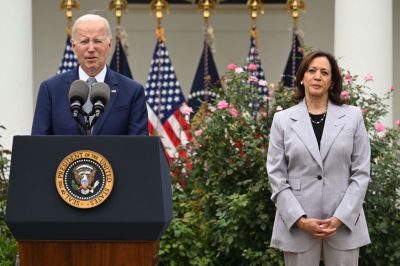Let’s imagine what the global security environment might look like at the start of a second four-year term of a Joe Biden presidency. The war in Ukraine is still ongoing, but public support for the war is waning even while Ukraine continues to make small, incremental gains against Russian forces. In the Middle East, Israel occupies most of Gaza, and Iran continues to challenge the U.S. and Israel militarily through its proxies while also racing to finish acquiring a nuclear weapon. Meanwhile China is engaging in even more provocative military operations—against Taiwan in the wake of the Democratic Progressive Party’s third straight victory in Taiwan’s presidential race and against treaty ally, the Philippines, over the Second Thomas Shoal. And, 2027—the year Chinese leader Xi Jinping has said that China’s military must be ready to invade Taiwan—is now only two years away.
Now imagine the following: On the day of President Biden’s second inaugural ceremony, it’s windy and bitterly cold. Instead of moving the event indoors Biden proceeds with the event on the Capitol steps. Not long after, he comes down with a cold, which eventually turns into pneumonia. Granted, that’s a dramatic and unlikely hypothetical, but just one of many voters must weigh given the president’s age: He could trip and fall during inaugural festivities, or the stresses of the presidency could induce a stroke. Whatever the case may be, his advanced age makes it more and more likely some physical ailment will force his Cabinet to decide whether to invoke the 25th Amendment and hand over the “powers and duties” of the Oval Office to recently reelected Vice President Kamala Harris.
Who would think this was a good idea? Who wouldn’t want a “do-over” in picking Biden’s running mate back in the summer of 2024? Early in his tenure, Biden tasked Harris with the border crisis and Central America policy and she fumbled, showing she was not ready for prime time. She has done nothing since to suggest she is any more ready now. Standing next to the president at important events—as she so often does—doesn’t translate into being able to stand in for him if necessary. And that certainly appears to be the view of the American public. Her favorability rating hasn’t been near 50 percent since September 2021. Since January 2022, her disapproval numbers have outstripped her favorability by double-digits—with the average in the recent months more than 16 points. These are remarkably negative numbers considering how little she appears on the public stage.
We’ve gotten used to presidents picking their running mates with an eye toward how it will help them win in the general election. How their choice for vice president might do if required to assume the presidency is typically an afterthought. And while we put the parties’ nominees through a taxing and extended electoral process that gives citizens some idea of the character and qualities of the candidates, we remained satisfied with the presidential candidates basically picking a name out of hat to run on the ticket. And then we remain satisfied with small tidbits of news about them on the campaign trail and a debate between the vice presidential candidates watched by mostly political junkies and the candidates’ extended families. This despite the fact, as then-Vice President John Adams remarked, “I am nothing but I may be everything.”
Presidential nominees picking their running mates wasn’t always thus. At the beginning, vice presidents were presidential candidates who came in second to the eventual winner. Adams served as George Washington’s vice president, and Thomas Jefferson was Adams’. While, as this second example shows, a president could have a political rival as his vice president, it was also the case that the vice president had been deemed by a significant percentage of the public to have the experience and qualities to be president.
This changed in the aftermath of the 12th Amendment, which required Electoral College electors to cast distinct votes for president and vice president, instead of just two votes for president. Combined with the rise of political parties, this meant that candidates for the presidency and vice presidency would run as a team. At first, the parties’ congressional caucuses chose their respective vice-presidential nominees, then later the choice was made at national conventions. Gradually, presidential candidates would have a say in making that choice, along with the party’s leadership. Not until Franklin Roosevelt did a presidential candidate insist on making the pick on his own.
Technically, both parties allow other candidates to be voted on at their respective national conventions. And the bar for being nominated is quite modest: for Democrats, a couple hundred signatures of support from delegates, with not more than 50 coming from a single state and, in the case of the Republicans, a plurality of signatures from at least five states. But it’s beyond wishful thinking to suppose that by the late date of the convention, either Democrats or Republicans would be willing to create headlines that they were questioning the judgment of their presidential nominee by challenging his VP selection.
Still, Donald Trump and Biden are both old men, which makes the selection of a running mate a vitally important matter. While it remains to be seen whether Trump will be the GOP nominee, his choice would undoubtedly be a MAGA stalwart whose loyalty to him will be the only real criteria for being picked. This is not like 2016 when “newcomer” Donald Trump needed a figure like Mike Pence to reassure key segments of the voting population. This time it will be a pure, unadulterated, Trumpian ticket.
Biden, on the other hand, while inclined to stick with Harris as his running mate, is less self-absorbed than Trump and must be aware that neither the general public nor his own staff sees her as an asset. Is Harris really going to help in swing states, or with independent voters? If the key issue is abortion, there are plenty of other, more experienced and respected Democrats to choose from who could run on that issue from the party’s perspective.
Presumably, Biden is concerned that dumping Harris will be seen as admitting he never should have chosen her to start with. But staying with the vice president will only increase the view that it was a mistake, given questions about his frailty and the dangers likely to confront the U.S. in the immediate years ahead. If the 2024 election turns in part, as it did in 2020, on the public’s confidence that Biden is to be trusted more than Trump to sit in the Oval Office, then choosing someone other than Harris can actually be turned into a positive sign about his judgment.
Recent news accounts indicate that the White House is trying to reverse the negative views about Harris by giving her an increased public role in the months ahead. But the very fact that they are having to do so now points to the reality that she hasn’t been an asset over the past three years. Hoping that the vice president will suddenly become something she hasn’t been is a long-shot bet that potentially will backfire when she shows she is unready to be the president-in-waiting. The race is likely to be too close to take that kind of chance.
When Biden moved into the White House, he made a point of hanging a portrait of FDR in a prominent spot in the Oval Office. One lesson he might take from the greatest of Democratic presidents is that he had three different running mates in his four presidential elections. It can be done. In the case of the upcoming election, it should be done.






Please note that we at The Dispatch hold ourselves, our work, and our commenters to a higher standard than other places on the internet. We welcome comments that foster genuine debate or discussion—including comments critical of us or our work—but responses that include ad hominem attacks on fellow Dispatch members or are intended to stoke fear and anger may be moderated.
With your membership, you only have the ability to comment on The Morning Dispatch articles. Consider upgrading to join the conversation everywhere.